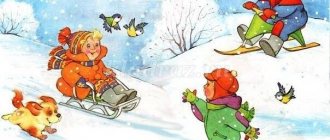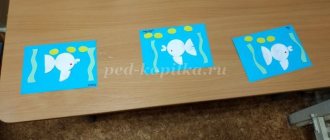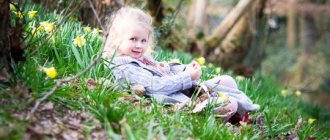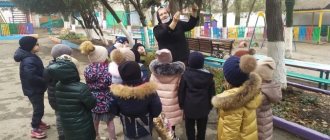Walks in the second junior group: a file cabinet according to the Federal State Educational Standard, an example of a note, etc.
A walk in kindergarten opens up great opportunities for the comprehensive and harmonious development of a child’s personality. Moreover, if we are talking about children of the second youngest group, whose age is 3–4 years.
Understanding the surrounding world, wildlife, increasing immunity - all this is possible through daily walks.
However, each stage of children’s stay on the street requires careful methodological preparation and competent implementation.
A walk for a child is an effective means of introducing him to the environment of his native place. It is not for nothing that outdoor leisure is considered one of the mandatory components of the educational process in a preschool child care institution.
Goals
The main purpose of the walk is to strengthen the baby’s immunity. Leisure on the street realizes it by adapting the children’s body to environmental conditions.
From a pedagogical point of view, children’s stay in the fresh air has 3 directions for goal setting: educational, developmental and educational.
In connection with this, the Federal State Educational Standard formulates the main goals of walking in the second junior group:
- prevention of colds and fatigue in children;
- training in nature-appropriate behavior (observing the weather, changing seasons, etc.);
- analysis of weather changes in the outside world;
- development of skills and abilities to record changes in the surrounding world;
- fostering a positive attitude towards nature, which determines the need to take care of it.
Daily walks help strengthen kids
In order to realize the goals, at each lesson, that is, at each walk, the teacher must deal with a whole set of problems:
- Demonstration of the beauty and perfection of everything created by nature.
- Getting to know the seasons, as well as the sights of your hometown, the work of adults (cleaning and landscaping streets, building houses, etc.).
- Introducing children to hardening procedures (for example, by washing their feet in cool water in the summer).
- Training the musculoskeletal system through physical activity (running, jumping, swinging legs and arms, etc.), improving the health of the body’s respiratory system.
- Development of self-care skills. For the second youngest group, this is the ability to dress without or with minimal help from an adult, wash, wash hands and dry yourself after a walk, the ability to ask to go to the toilet, blow your nose - before and while being outside.
- Fostering a responsible attitude towards nature and people.
A walk in a junior preschool group lasts no more than 4 hours in 2 doses in winter; in summer, kids spend almost all their time outside and come into the group only to eat and sleep.
The condition for spending leisure time on the street is that the group’s site complies with sanitary standards and the requirements of the organization of the educational process:
- The presence of a landscaped and well-planned area, which has a sandbox, swings and/or climbing ladders, etc. Moreover, all elements of the playground must be checked daily in the morning for the presence of garbage, as well as objects that threaten the life and health of children.
- On the territory of the open area there should be a place specially designated for rainy weather, for example, a gazebo. In winter, adults teach and then help the children sculpt snow figures.
- All equipment (toys, tools - brooms, brooms, etc.) must be safe for the health of children.
Source: https://melkie.net/organizatsiya-dnya/kartoteka-progulok-vo-vtoroy-mladshey-gruppe.html
Winter. Card file of walks with children of the second junior group
Larisa Petrovna Kruglova
Winter. Card file of walks with children of the second junior group
December
Walk 1
Observing freshly fallen snow - forming an idea of winter; evoke an aesthetic experience from the beauty of winter nature, the joy of a walk .
Work. Removing snow from the site - learn to use a shovel.
Outdoor game “Birds are flying”
- develop motor activity.
Individual work. Throwing snowballs at a distance.
Walk 2
Bird watching in winter - give an idea of the life of birds in winter; teach children to help them.
Work. Raking snow with shovels - learn to work together, to achieve a goal with common efforts.
Outdoor game “Birds are flying”
— learn to act quickly on a signal; run without bumping into each other.
Individual work. "Hit the target"
— practice throwing at a target, develop dexterity.
Walk 3
Observation of trees - to develop knowledge about plant life in winter; cultivate a caring attitude towards nature.
Work. Clearing the paths - learning to work together, to achieve goals through joint efforts.
Outdoor game “Birds are flying”
— Teach children to jump from low objects, run in all directions, and act only when given a signal.
Individual work. Jumping on two legs over a line.
Walk 4
Observing the work of a janitor in winter - expand knowledge about the work of adults; develop respect for their work.
Work. Clearing the area of snow - encourage the teacher to help clear the area of snow.
Outdoor game “Birds are flying”
- learn to run without bumping into each other.
Individual work. Game exercise “Walk along the path”
- learn to walk in a straight line.
Walk 5
Observing snowfall - to form ideas about winter weather phenomena, expand children's horizons, activate vocabulary: “snow”
,
"
winter " ,
"cold"
.
Work. Construction of a snow bed - learning to shovel snow into a certain place.
Outdoor game “Birds are flying”
- increase physical activity while
walking ;
Individual work. Strengthen your ability to jump.
Walk 6
Monitoring cars – involve in monitoring transport.
Work. Clearing paths covered with snow - learn how to use a shovel correctly, and finish what you start.
Outdoor games “Sparrows and a car”
- learn to correlate your own actions with the actions of the participants in the game.
Individual work. Practice jumping forward.
Walk 7
Watching the snow - continue to get acquainted with various natural phenomena.
Work. Raking snow with shovels, clearing an area for games - teach them to work together, to achieve a goal through joint efforts.
Outdoor game “Sparrows and a car”
- teach to run quickly at the teacher’s signal, without looking back.
Individual work. Learn to group when climbing into a hoop.
Walk 8
Observing a birch tree - expanding your understanding of the tree.
Work. Clearing the area from snow - teach how to help the teacher in performing work actions.
Outdoor game “Sparrows and a car”
- learn to listen carefully to the teacher’s command; develop attention, monitor the correct completion of tasks.
Individual work - teach how to walk on a snow bank, jump off, bending your knees.
Walk 9
Bird watching - develop powers of observation and interest in wildlife.
Work. Let's feed the birds - cultivate a caring attitude towards birds.
Outdoor game “Birds in Nests”
— learn to run freely, without bumping into each other, to respond to a signal, returning to their place.
Individual work. Jumping on two legs while moving forward.
Walk 10
Observing a cat - consolidate the idea of the cat: appearance, movements, sounds made.
Work. Building a slide for a doll - teach how to properly fill a bucket with snow and pour it into a certain place.
Outdoor game “Birds in Nests”
learn to act quickly on a signal; run without bumping into each other.
Individual work. Jumping on two legs “From circle to circle”
.
Walk 11
Observation of the spruce tree - enrich and activate children's vocabulary.
Work. Clearing the area from snow - learn how to use a shovel correctly, carry snow for construction, and finish what you start.
Outdoor game “Birds in Nests”
learn to act quickly on a signal; run without bumping into each other.
Individual work. "On a smooth path"
- learn to walk on snow banks; jump off, bending your knees.
Walk 12
Observing a tit is to consolidate the idea of birds and their characteristic appearance.
Work. Let's feed the birds - cultivate a desire to take care of birds.
Outdoor game “Find your home”
— teach children to act quickly on a signal; run without bumping into each other.
Individual work. "Get in the Box"
- train accuracy of throws.
Walk 13
Observation of transport - develop stability of attention, cognitive interest.
Work. Construction of a garage from snow - learn how to use shovels and brooms correctly; bring the job started to completion.
Outdoor game “Find your home”
- learn to navigate in space.
Individual work. Practice shooting accuracy at the target.
Walk 14
Observing the work of adults - to cultivate interest in the work of adults.
Work. Decorating the area with snow cakes - learn how to tightly fill a mold with snow, knock the snow out of it, and decorate the shafts with the resulting cakes.
Outdoor game “Who will run to the Christmas tree faster?”
- learn to run without bumping into each other.
Individual work. Game exercise “Step over the obstacle”
.
Walk 15
Observing the work of a janitor - to cultivate interest in the work of adults
Work. Clear buildings of snow - help the teacher in performing work activities; bring the job started to completion.
Outdoor game "Trap"
— consolidate the ability to run quickly, catch someone running away, and be attentive in the game.
Individual work. Running between two lines - develop coordination of movements.
Walk 16
Observing a birch tree - expand your understanding of the tree; cultivate an interest in nature.
Work. Clearing paths of snow - help the teacher in performing work activities.
Outdoor game "Trap"
— consolidate the ability to run quickly, catch someone running away, and be attentive in the game.
Individual work. Learn to walk on snow banks; jump off, bending your knees.
Walk 17
Observing the properties of snow - introduce the properties of snow (cold, white, crunchy)
.
Work. Raking snow with shovels, clearing a path - learn how to use a shovel correctly.
Outdoor game "Trap"
- teach to follow the rules of the game, act on the teacher’s signal.
Individual work. Game exercise “Raise your legs higher”
- learn to step over objects.
Walk 18
Observing a dog - consolidate the idea of the dog: appearance, movements, sounds made.
Work. Clearing the path - learn how to use a shovel correctly.
Outdoor game "Planes"
- teach to follow the rules of the game, act on the teacher’s signal.
Individual work. Game exercise “Raise your legs higher”
- learn
step over objects.
Walk 19
Bird watching - to consolidate the idea of birds, their characteristic appearance signs.
Work. Let's feed the birds - cultivate a desire to take care of birds.
Outdoor game "Planes"
— learn to act quickly on a signal; run without bumping into each other.
Individual work. "Get in the Box"
- train accuracy of throws.
Walk 20
Observing passers-by - develop attention and observation.
Work. Clearing the playground - teach to work together, to achieve goals through joint efforts.
Outdoor game "Planes"
- teach to run quickly at the teacher’s signal, without looking back.
Individual work. Running between two lines - develop coordination of movements.
Walk 21
Observation of transport - develop stability of attention, cognitive interest.
Work. Construction of a garage out of snow - learn how to use shovels correctly; bring the job started to completion.
Outdoor game “Find your home”
- learn to navigate in space.
Individual work. Practice shooting accuracy at the target.
January
Walk 1
Observing the sun - continue to get acquainted with natural phenomena.
Work. Shoveling snow - learn how to use a shovel correctly and work together.
Outdoor game “Run to the flag”
- learn to perform actions strictly according to the teacher’s signal.
Individual work. “Who will throw the snowball next?”
- teach the correct swing.
Walk 2
Observation “How are passers-by dressed?”
- develop observation skills
Work. Raking snow with shovels, clearing paths - learn to work together, to achieve a goal through joint efforts.
Outdoor game “Run to the flag”
— train coherence of collective actions, speed of reaction.
Individual work. "Don't get your feet wet"
— learn to jump over obstacles and land on both feet.
Walk 3
Observing the properties of snow - continue to familiarize yourself with the properties of snow (cold, white, crunchy)
.
Work. Shoveling snow from the path - learn how to use shovels correctly.
Outdoor game “Run to the flag”
— train coherence of collective actions, speed of reaction.
Individual work. "Get in the circle"
- learn to hit the target.
Walk 4
Watching snowfall helps form an idea of your surroundings.
Work. Construction of buildings from snow - learn to shovel snow using shovels to a certain place.
Outdoor game “Run to the flag”
- learn to perform actions as directed by an adult.
Individual work. "From pebble to pebble"
- learn to land easily.
Walk 5
Bird watching - reinforces children's desire to care for birds.
Work. Feeding birds in the kindergarten area is to cultivate love, caring and caring attitude towards wintering birds.
Outdoor game "Hares and wolves"
- learn to act quickly on a signal.
Individual work. “Knock down the pins”
(3-5 pins and 1 ball)
- teach the correct swing.
Walk 6
Observation of trees - to cultivate a caring attitude towards nature.
Work. Raking snow with shovels, clearing a path - learn to work together, achieve a goal with common efforts. Outdoor game "Hares and wolves"
- learn to run without bumping into each other. Individual work. Jumping on two legs with advancement.
Walk 7
Observation of birch and pine trees - to cultivate a caring attitude towards nature.
Work. Path construction - learn how to properly carry snow for construction.
Outdoor game "Hares and wolves"
- learn to run without bumping into each other.
Individual work. Game exercise “Walk along the path”
- learn to walk in a straight line.
Walk 8
Observation. Pay attention to the beauty of the winter landscape (it’s white all around, the snow sparkles in the sun, the sky is blue)
.
Work. Clearing paths of snow - teach how to use shovels to shovel snow.
Outdoor game "Hares and wolves"
- learn to be attentive to your playing partners.
Individual work. "Don't miss the ball"
— learn to pass the ball without dropping or stopping.
Walk 9
Watching snow - continue to get acquainted with the natural phenomenon.
Work. Clearing the path to the site - teach how to use shovels when shoveling snow.
Outdoor game "Hares and wolves"
- learn to run freely without bumping into each other.
Individual work. Jumping on two legs.
Walk 10
Observing freshly fallen snow - To develop in children the ability to notice unusual things in nature: freshly fallen snow, its whiteness, temperature.
Work. Clearing the area from snow - teach how to use shovels and brooms correctly, and finish the job you start.
Outdoor game “Sparrows and a car”
— learn to act quickly on a signal, navigate in space.
Individual work. Jumping - develop jumping ability.
Walk 11
Observation of a cat - to form ideas about domestic animals, what benefits they bring to people, to practice pronouncing onomatopoeia, to develop memory, speech, to form ideas about the correct ways to interact with animals. Work. Construction of a snow bed - learning to shovel snow into a certain place. Outdoor game “Sparrows and a car”
- learn to navigate in space.
Individual work. "Hit the target"
- develop eye and throwing power.
Walk 12
Observing trees in frost is to cultivate in children aesthetic feelings from the beauty of the surrounding nature.
Work. Collect removal material and clear it of snow.
Outdoor games “Sparrows and a car”
- practice running in different directions, the ability to navigate in space.
Individual work. Learn to throw snowballs into the distance
Walk 13
Observing freshly fallen snow - arouses interest in snow as an unusual material - traces remain in the snow, you can draw on it. Show children how snow scatters with the wave of a hand, teach them to find traces of people and their own, traces of a dog, a bird, not necessarily all at once - you can wait until the next observation. Learn to notice beauty in your surroundings. After observation, children can be offered non-sharp sticks and signets for independent drawing in the snow.
Work. Raking snow into a common pile to build a slide - teach how to use shovels, shoveling snow into a certain place.
Outdoor game “Sparrows and a car”
- increase physical activity while
walking .
Individual work. Jumping on two legs over a line.
February
Walk 1
Watching freshly fallen snow teaches you to notice the beauty in your surroundings. After observation, children can be offered non-sharp sticks and signets for independent drawing in the snow.
Work. Raking snow with a shovel, clearing paths - learn to work together.
Outdoor game “Sparrows and a car”
- learn to perform actions strictly according to the teacher’s signal.
Individual work. Running between two lines - develop coordination of movements.
Walk 2
Bird watching - how birds fly to a feeder if a person feeds them with grains and crumbs. Develop a desire to help birds in winter.
Work. Clearing paths of snow - strengthen your skills in working with a shovel.
Outdoor game “Run to the flag”
- practice orientation in the area.
Individual work. Learn to throw snowballs into the distance
Walk 3
Observation. Admire the calmly falling snowflakes and snowdrifts glistening in the sun. Examine the snowflake on the sleeve of the jacket.
Work. Clearing the path to the site - consolidate skills in working with shovels by shoveling snow into a certain place.
Outdoor game “Run to the flag”
— teach to run freely, without bumping into each other, to respond to a signal, returning to your place.
Individual work. Walking between two lines is to develop coordination of movements.
Walk 4
Watching a dog - to form ideas about pets, what benefits they bring to people, to practice pronouncing onomatopoeia, to develop memory and speech, to form ideas about the correct ways to interact with animals.
Work. Construction of a snow bed - continue to teach how to properly carry snow for construction.
Outdoor game “Run to the flag”
- increase physical activity while
walking .
Individual work. Learn to walk on a boom, jump, bending your knees.
Walk 5
Observation of wintering birds - to form an idea about birds.
Work. The construction of a path reinforces the ability to use shovels, shoveling snow, and make a path.
Outdoor game “Birds are flying”
- develop motor activity.
Individual work. Learn to walk on a boom, jump, bending your knees.
Walk 6
Observation of snow - develop observation skills. Show children tracks of birds, dogs, cats in the snow.
Work. Clearing paths of snow and debris is to cultivate hard work.
Outdoor game “Birds are flying”
- increase physical activity while
walking .
Individual work. "Hit the Hoop"
- develop accuracy, agility, endurance.
Walk 7
Observation “Footprints in the snow”
- learn to identify tracks: children's, adults, animal tracks.
Work. Show children how to build a house out of snow for a doll or animal - teach them to compare the size of the house with the size of the toy;
Outdoor game “Birds are flying”
- increase physical activity while
walking .
Individual work. Learn to crawl straight or sideways over the shaft.
Walk 8
Observation "Birds in winter"
- strengthen the desire to take care of birds.
Work. Building a slide for a doll - teach how to correctly fill a bucket with snow to a certain level;
Outdoor game “Catch me”
- learn to navigate in space.
Individual work. Jumping - develop jumping ability.
Walk 9
Observation of a cat - to form ideas about domestic animals, what benefits they bring to people, to practice pronouncing onomatopoeia, to develop memory, speech, to form ideas about the correct ways to interact with animals.
Work. Shoveling snow is a lesson in working together and achieving a goal through joint efforts.
Outdoor game “Catch me”
- learn to navigate in space.
Individual work. Learn to crawl straight or sideways over the shaft.
Walk 10
Watching snowfall helps form an idea of your surroundings.
Work. Building a house for a bunny - teach how to shovel snow using shovels to a certain place.
Outdoor game “Catch me”
- learn to navigate in space.
Individual work. Game exercise “Walk along the path”
- learn to walk in a straight line.
Walk 11
Observing the wind - continue to build knowledge about one of the signs of winter - blizzards.
Work. Clearing the area of snow - improve work skills.
Outdoor game “Catch me”
- learn to navigate in space.
Individual work. "Roll to the target"
- develop eye and accuracy.
Walk 12
Observing the sky - forming an idea of the sky.
Work. Shoveling snow is a lesson in working together and achieving a goal through joint efforts.
Outdoor game “Birds are flying”
- learn to act on a signal.
Individual work. "Roll to the target"
- develop eye and accuracy.
Walk 13
Snow observation - continue to introduce children to the natural phenomenon of snow.
Work. Clearing a path covered with snow - learn how to use a shovel correctly and finish what you start.
Outdoor game “Birds are flying”
- learn to act on a signal.
Individual work. "One - two"
- when moving in pairs, learn to balance your movements with the movements of your partner.
Walk 14
Observing the sky - continue to get acquainted with various natural phenomena.
Work. Raking snow with shovels, clearing a playground - teach them to work together, to achieve goals through joint efforts.
Outdoor game “Sparrows and a car”
- learn to correlate your own actions with the actions of the participants in the game.
Individual work. Learn to crawl straight or sideways over the shaft.
Walk 15
Observation. Admire the calmly falling snowflakes and snowdrifts glistening in the sun. Examine the snowflake on the sleeve of the jacket.
Work. Clearing the path to the site - consolidate skills in working with shovels by shoveling snow into a certain place.
Outdoor game “Sparrows and a car”
- learn to correlate your own actions with the actions of the participants in the game.
Individual work. Walking between two lines is to develop coordination of movements.
Walk 16
Observation. Pay attention to the beauty of the winter landscape (it’s white all around, the snow sparkles in the sun, the sky is blue)
.
Work. Clearing paths of snow - teach how to use shovels to shovel snow.
Outdoor game “Sparrows and a car”
- learn to correlate your own actions with the actions of the participants in the game.
Individual work. "Don't miss the ball"
— learn to pass the ball without dropping or stopping.
Walk 17
Observing a cat - consolidate the idea of the cat: appearance, movements, sounds made.
Work. Building a slide for a doll - teach how to properly fill a bucket with snow and pour it into a certain place.
Outdoor game “Sparrows and a car”
- learn to correlate your own actions with the actions of the participants in the game.
Individual work. Jumping on two legs “From circle to circle”
.



